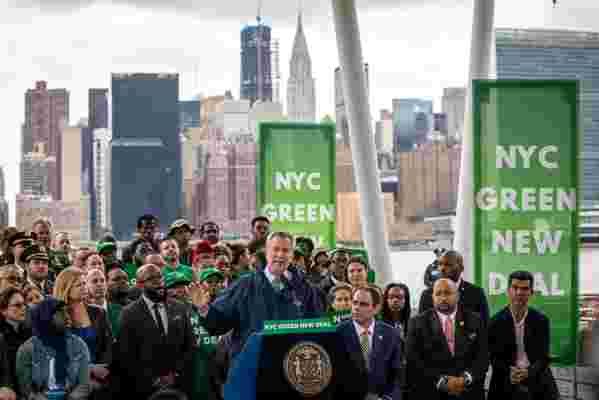One of the great pleasures of New York City’s skyline, as of its people, is the exuberant mix of styles. When you close your eyes and picture New York, you see the Empire State Building’s spire , the Chrysler Building’s Art Deco curves, and an eclectic assortment of more recent skyscrapers, many with shiny, sun-catching façades. What you don’t see is the carbon footprint of all those supertalls. According to the Mayor’s office, buildings account for nearly 70 percent of the city’s greenhouse gas emissions, with giant towers operating as the worst polluters. But identifying a problem is one thing, fixing it is far trickier.
This week, New York City Mayor Bill de Blasio took umbrage with specific type of architecture, threatening an all-out ban on “classic glass and steel skyscrapers, which are incredibly inefficient.” The mayor was speaking about new construction, and tempered his comments a little by explaining, “If someone wants to build one of those things, they can take a whole lot of steps to make it energy efficient, but we’re not going to allow what we used to see in the past.”
According to city officials, no laws or policies have yet been drafted; Mayor de Blasio’s proposal, while strong in sentiment, contains more bark than bite. There will not be an outright ban on glass and steel for new construction, but there will be certain energy-efficient standards that buildings will have to meet, the specifics of which are not yet clear.

New York City Mayor Bill de Blasio speaks about the city's strategy to respond to climate change at Hunter's Point South Park in Queens on Earth Day.
The mayor’s remarks struck many of the city’s architects as odd, mainly because there have been great advancements in green building techniques, and designers can now create more carbon-neutral towers using all kinds of materials, including triple-pane glass panels. Why ban anything that gets the job done?
“I think I was as curious as other people,” said Ben Prosky, executive director of the American Institute of Architects New York. “Just because you see a lot of glass doesn’t mean it’s not green, and just because you see a lot of concrete doesn’t mean it is green.”
Mayor de Blasio’s remarks come on the heels of another measure taken to curb climate change—last week, New York’s City Council passed a series of bills called the Climate Mobilization Act, which require buildings with more than 25,000 square feet (think in general of anything bigger than a five-story walk-up) to reduce carbon emissions by 40 percent in the aggregate over the next ten years . . . or face significant fines.
Mark Chambers, director of the Mayor’s Office of Sustainability, says landlords have an array of options to meet the new requirements, from installing solar panels to doubling down on insulation or simply keeping better track of when rooms are occupied. “Not everything has to be bells and whistles, just turn things off when they’re not being used,” said Chambers. “We have to fight for every square foot of efficiency in a city that has a million buildings.”
Regardless of how owners cut emissions—and New Yorkers are nothing if not creative, they’ll do anything to avoid a fine—their actions will be watched globally. As City Council Speaker Corey Johnson tweeted the day the carbon reduction measures passed, “We are on the precipice of climate disaster, and New York City is acting. I hope other cities follow suit.”
